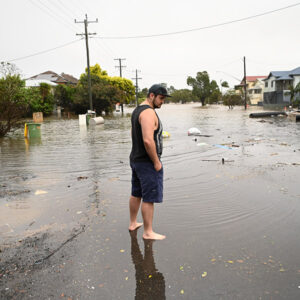Pictured: Professor Martin Thoms, University of New England
“The reality is that in any given year there is a 1% chance any floodplain will be inundated.” Professor Martin Thoms, University of New England
“There is always a small risk and that is what a lot of people call a one-in-a-100-year event. But, in reality, some parts of that floodplain will be flooded more frequently; we’ve seen that some are being flooded every year,” he says.
In Australia, instead of working with the natural cycles of the floodplains and practising flood recession agriculture, we have attempted to dominate nature and try to stop the flooding by putting up levee banks. The results are what we are seeing now, says Thoms.
“I am not an advocate of not living and working on floodplains, but I think we’ve lost the synergies to work with floodplains and we need to rediscover that balance and help people manage the risk,” he says.
Cyclone Gabrielle is just one of the disasters given the once-in-a-100-years tag recently. It came close on the heels of the devastating flooding seen in late February 2022 in Lismore, NSW and the damage caused on the floodplains of theMurray River in Victoria in October 2022. Queensland has also been severely affected by flooding in recent years.
With rebuilding underway in some flood-affected areas in both countries, questions are being asked about how communities can better prepare for these types of natural disasters in the future – including the trickiest one – should we even live on floodplains in the first place?
There is no simple answer to that question, argues Sharanjit Paddam, principal and actuary at Finity Consulting. Untangling the relationship we have with floodplains means looking at a range of issues, he argues.
That includes building resilience, and increasing options for households and businesses; making the hard call to abandon some areas through managed retreats; and, most importantly, addressing the fact that many people rebuild or buy on floodplains because that is all they can afford.
“From my point of view, we need to stop people building in flood zones, but we also have to understand the reason people do it is mainly because of affordability and because that is where their communities and social connections are,” says Paddam.
“For that reason, we also need to look at ways of helping people protect themselves from natural disasters and not just rely on bailing people out when disaster hits,” he says.
Retreating from danger
In some areas, no matter how resilient people are, the only course of action may be to leave through a process coined a managed retreat, or planned relocation. It’s a fraught topic and one that causes enormous trauma for communities that are affected, as well as raising questions about who foots the bill.
However, around 750,000 New Zealanders and about 500,000 buildings worth more than NZ$145 billion are located near rivers and in coastal areas which are already exposed to extreme flooding.
“In the future, it will not be a case of if more extreme weather events happen, but how often and how severe. Those who are already struggling are likely to be hardest hit, while least able to afford it,” says a spokesperson from the New Zealand Ministry for the Environment.
“We need to protect our people, especially our most vulnerable communities, as well as businesses and infrastructure. Options include building sea walls or levees or raising properties. However, in some areas it is already becoming clear that these can only be temporary solutions and communities feeling the most severe impacts of climate change face some difficult choices.”
In New Zealand, the country’s only managed retreat to date has been the coastal town of Matatā, which was inundated by debris flows in 2005, triggered by intense rainfall. Reports indicated the retreat was a difficult process and some important lessons were learned, namely: recognising the huge trauma relocating causes people. It may be the only retreat so far, but the introduction of the Climate Adaptation Act this year will lay the foundations of a system for managed retreat and adaptation, which may lead to more communities facing retreat.
In Australia, the prohibitive cost of insurance and the threat of natural disaster led IAG to release a report outlining the economic viability of planned relocation as a strategy in high-risk areas. “Finity, in a green paper for the Actuaries Institute in 2022, estimated that one in 10 Australian households already has insurance premiums that are likely to be unaffordable. They’re more than 10% of their gross income – and climate change is going to make that worse,” says Paddam. “IAG’s recently released report on planned relocation makes seven policy recommendations on how to manage the process.”
One of those recommendations is that community involvement throughout the process is essential for successful implementation.
















